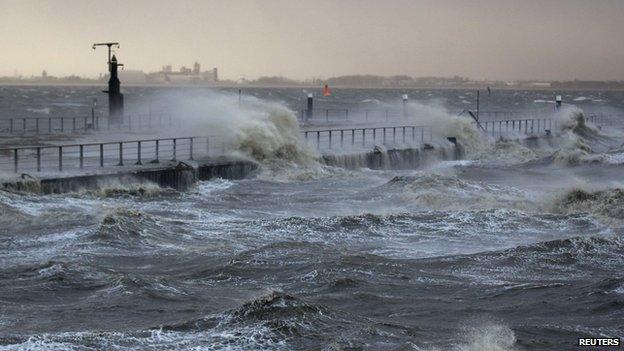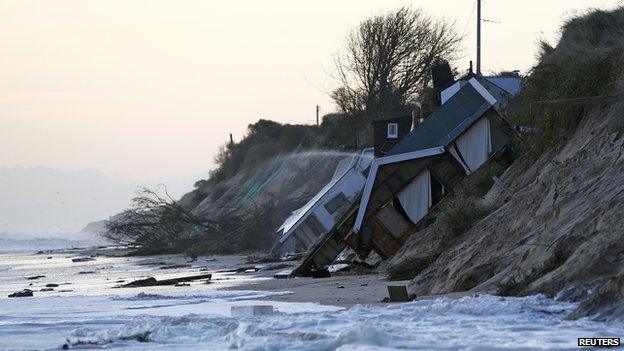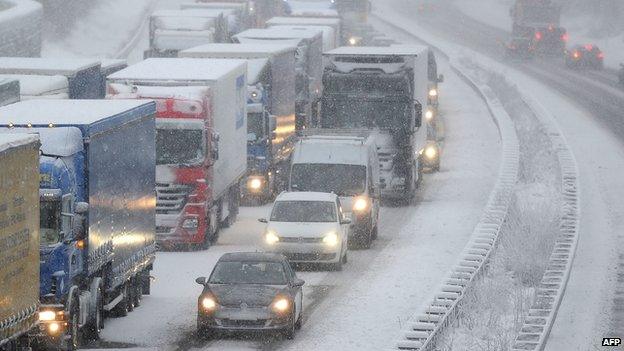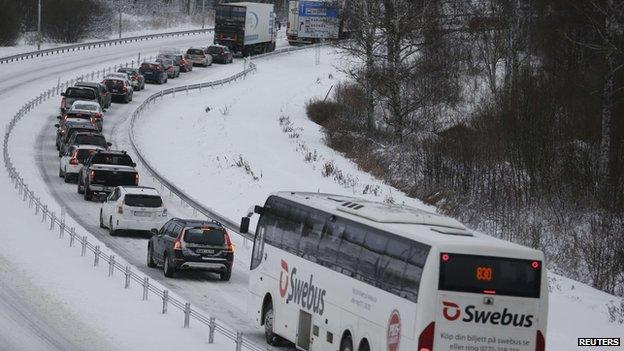Deadly storm and tidal surge batter northern Europe
- Published
Anna Holligan reports from the Hook of Holland ferry port
Hurricane-force winds and tidal surges have killed at least seven people in northern Europe, flooded parts of Hamburg and left thousands of homes without electricity.
The storm, called Xaver, blew a tree on to a car in Poraj, northern Poland, killing three people inside.
The storm also caused two deaths in the UK, one in Sweden and one in Denmark.
Dozens of flights have been cancelled, hitting travellers at Berlin Tegel, Copenhagen and smaller airports.
Many rail and ferry services were also cut in Germany and Scandinavia.
There is severe disruption in southern Sweden, with all rail services cancelled in the Skane region. Planes have been grounded at Sturup airport and Gothenburg's Landvetter airport, Radio Sweden reports.
Fallen trees have blocked many roads in southern Sweden and heavy snow is adding to the chaos.
More than 1,000 people spent the night at Copenhagen airport.
In eastern England about 10,000 homes were evacuated in Norfolk and Suffolk. Several homes collapsed into the sea at Hemsby when the storm battered the clifftop.
The Thames Barrier was closed for a second day to protect London from the surge.
Many schools have been closed across the north of Poland and Germany. Winds gusted at nearly 150km/h (93mph) in northern Germany.
In Poland at least 400,000 homes are without electricity because of severed power lines.
Thousands of homes were also left without power in Sweden and Norway on Friday, the Associated Press news agency reports.
The port of Hamburg, which handles a huge amount of European trade, was shut overnight, but has now reopened.

Residents of Hamburg woke up to find the historic fish market flooded

Helsingborg, southern Sweden: The coast road was flooded

The tidal surge battered Emden in north Germany, near the Dutch border

The storm at Hemsby, eastern England, pushed several homes off the cliff

In Scotland, a lorry driver was killed when his vehicle blew over.

Heavy snow caused traffic chaos at Olpe, near Germany's industrial Ruhr region

There were also traffic jams in snowy parts of southern Sweden
Hamburg has experienced its biggest tidal surges since the 1960s. The city's fish market and some streets by the river Elbe were flooded.
The river there rose 6m (20ft) above its average level, and the authorities are warning of a fresh surge expected on Friday evening.
There was also limited flooding in the Netherlands - officials say the sea dykes withstood the onslaught.
A woman died in Denmark after a lorry was blown over.
The Oeresund road-rail bridge, linking Copenhagen in Denmark with Malmo in southern Sweden, has reopened. It had been closed on Thursday evening amid high winds.
Workers boarded up the windows of the Viking Ship Museum at Roskilde, just west of Copenhagen, fearing the high winds would shatter the glass.
In Scotland a lorry driver was killed on Thursday when his vehicle was blown over near Edinburgh. A man was crushed by a falling tree in Nottinghamshire, central England.
On Thursday winds of up to 228km/h (142 mph) battered Scotland.
England's east coast experienced its worst tidal surge in 60 years, while in north Wales residents had to be rescued by lifeboat crews.
Two sailors were reportedly swept overboard from a ship 22 km (14 miles) off the southern Swedish coast, and air-sea rescue services failed to find them.
Weather presenter Matt Taylor explains how a storm surge happens
In the low-lying Netherlands, the Eastern Scheldt storm surge barrier was closed off for the first time in six years. Dutch authorities said they had issued the highest possible flood warning for four areas in the north.
There was some flooding in Dordrecht and Rotterdam. But rail services are generally running normally in the Netherlands, the NOS news agency reports.
In Schleswig-Holstein, north Germany, many rail services have been halted. Fallen trees are littering railway lines.
On Thursday dozens of flights were cancelled at Amsterdam's Schiphol airport, but now Schiphol is back on schedule, NOS reports.
- Published6 December 2013
- Published5 December 2013
- Published6 December 2013
- Published6 December 2013
- Published5 December 2013
- Published5 December 2013
- Published5 December 2013